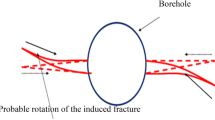Abstract
The pressuremeter test in boreholes has proven itself as a useful tool in geotechnical explorations, especially comparing its results with those obtained from a mathematical model ruled by a soil representative constitutive equation. The numerical model shown in this paper is aimed to be the reference framework for the interpretation of this test. The model analyses variables such as: the type of response, the initial state, the drainage regime and the constitutive equations. It is a model of finite elements able to work with a mesh without deformation or one adapted to it.










Similar content being viewed by others
References
AENOR (1999) Geotecnia. Ensayos de campo y de laboratorio, Normas UNE, Madrid
Arrua PA, Aiassa G (2009) Horizonal load transference p-y curve for silty loess soils. EIA 4:131–143
Aubeny CP, Whittle AJ, Ladd CC (2000) Effects of disturbance on undrained strengths interpreted from pressuremeter tests. J Geotech Geoenviron Eng 126:1133–1144
Benoit J (1995) Advances in pressuremeter technology with specific reference to clays. In: The pressuremeter and its New Avenues, Proceedings of the 4th international symposium on pressuremeters. Sherbrooke, Balkema, pp 125–139
Brinkgreve RBJ (2004) Refrencia manual PLAXIS versión 8.1. Delf University of Technology and PLAXIS, Delf
Clough GW (1990) The development of pressuremeter testing. In: Proceedings of the third international symposium on pressuremeters. Organised by British Geotechnical Society and held at Oxford University, p 25. American Society of Civil Engineers
Dincer I, Aarr A, Ural S (2008) Estimation of strength and deformation properties of quaternary caliche deposits. Bull Eng Geol Environ 67(3):353–366
Haberfield CM, Johnston IW (1990) A numerical model for pressuremeter testing in soft rock. Geotechnique 40:569–580
Morilla I (2012) Interpretación de los ensayos geotécnicos en suelos. Madrid, pp 401–421
Schanz T, Vermeer PA, Bonnier PG (1999) The hardening soil model: formulation and verification. In: Beyond 2000 in Computational Geotechnics - 10 Years of PLAXIS. Balkema, Rotterdam. ISBN 90 5809 040 X
Yagiz S, Akyol E, Sen G (2008) Relationship between the standard penetration test and the pressuremeter test on sandy silty clays: a case of study from Denizli. Bull Eng Geol Environ 67:405–410
Acknowledgments
The authors of this paper wish to thank the company EUROCONSULT for the support provided in preparing the paper presented.
Author information
Authors and Affiliations
Corresponding author
Rights and permissions
About this article
Cite this article
Escolano Sánchez, F., Bueno Aguado, M. & Lavín, J.R.S. Interpretation of the pressuremeter test using numerical models based on deformation tensor equations. Bull Eng Geol Environ 73, 141–146 (2014). https://doi.org/10.1007/s10064-013-0528-x
Received:
Accepted:
Published:
Issue Date:
DOI: https://doi.org/10.1007/s10064-013-0528-x




